Chiropractic
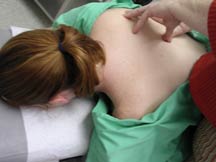 The art and science of chiropractic is primarily concerned with the interrelationship of structure and function. Proper alignment of the bones in the spinal column and proper cranial motion allows all the organs to function optimally.
The art and science of chiropractic is primarily concerned with the interrelationship of structure and function. Proper alignment of the bones in the spinal column and proper cranial motion allows all the organs to function optimally.Life is motion
Fixations in either the 21 moving parts of the cranium or the 24 bones of the spinal column result in interference with the neurological biofeedback mechanisms which coordinate and regulate your physiology.
The body is in a state of dynamic tension. Most of the important regulatory mechanisms are negative feedback loops. For example, the pituitary is the master gland of the endocrine system. It secretes hormones which turn on the thyroid. In response, the thyroid begins to secrete hormones; and the rising level of thyroid hormone turns off the pituitary. The mechanism is similar to a toggle switch.
 This same type of biofeedback mechanism is at work in the spine and nervous system. However, the target endpoints are organs and muscles, not glands. Each biofeedback loop has been described by classical neurology. a) viscerosomatic: an organ malfunctions and sends pain and spasm into the spinal column, b) somatovisceral: a misaligned and fixated vertebra affects the organ's function, c) somatosomatic: one level of the spinal column affects another level or an extremity or d) viscerovisceral: one organ affects another. How the different feedback loops interact is overseen by the craniosacral portion of the autonomic nervous system which regulates the parasympathetics, balancing the adrenal glands which activate the sympathetic portion of the autonomic nervous system. The parasympathetic/sympathetic balance is another elegant biofeedback loop which orchestrates the ebb and flow of physiologic functions and hormones within your body.
This same type of biofeedback mechanism is at work in the spine and nervous system. However, the target endpoints are organs and muscles, not glands. Each biofeedback loop has been described by classical neurology. a) viscerosomatic: an organ malfunctions and sends pain and spasm into the spinal column, b) somatovisceral: a misaligned and fixated vertebra affects the organ's function, c) somatosomatic: one level of the spinal column affects another level or an extremity or d) viscerovisceral: one organ affects another. How the different feedback loops interact is overseen by the craniosacral portion of the autonomic nervous system which regulates the parasympathetics, balancing the adrenal glands which activate the sympathetic portion of the autonomic nervous system. The parasympathetic/sympathetic balance is another elegant biofeedback loop which orchestrates the ebb and flow of physiologic functions and hormones within your body.At the RFHC, we use the most sophisticated and precise non-force adjustive techniques. Precision is paramount. Keep in mind that each level of the spine relates to a different organ and must move properly to keep that organ functioning well. That is why we stress: LIFE IS MOTION.
Each level of the spine and each bone of the cranium (45 moving parts, in all) is evaluated for both fixation and malposition in order to restore normal motion to the bony structures. When combined with other state of the art techniques used here at the RFHC, the result is your body regaining optimum physiologic function and structural balance. This level of precision and comprehensiveness makes our practice one of a kind. Each person is approached as a unique individual. "One size fits all" adjusting does not meet our standard of care. Experience the difference for yourself.
Does this seem helpful? If so, see our information on Consultations.
[TOP]
Category I Complex
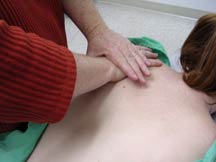 Category I is the underlying meningeal (dural) twist that a person develops as a result of the birthing process. The Category I Complex is obscured by any superimposed trauma which may have occurred during your lifetime. Once the traumas are resolved, your specific Category I pattern will become apparent.
Category I is the underlying meningeal (dural) twist that a person develops as a result of the birthing process. The Category I Complex is obscured by any superimposed trauma which may have occurred during your lifetime. Once the traumas are resolved, your specific Category I pattern will become apparent.The twist in the dura results in a variety of dysfunctions as a result of the impact on the nervous system. It can include cranial lesions, but they are not always present. Since the central nervous system controls the physiology of all the visceral organs, the most common symptom of Category I Complex is organ dysfunction. Some common organ problems found with Category I Complex include, but are not limited to: gall bladder disease, digestive upset (including ulcers), reproductive dysfunction (including impotence and painful intercourse), respiratory problems (including asthma) and cardiac rhythm problems of all kinds.
During the course of your lifetime, you will be either an active or an inactive Category I. An inactive Category I has no visceral interference, no cranial lesions and no subluxation of the sacroiliac joint. The person who is an inactive Category I has no need for chiropractic adjustments.
An active Category I is a different story. It is very important that it be corrected as soon as possible to prevent the development of visceral distress, dysfunction and disease. You will be able to tell that your Category I Complex has reactivated when the primary indicator of the Category I Complex (heel tension) returns. You will have heel tension (either right or left) which will remain constant throughout your lifetime when you are in an active Category I state. You can test yourself by sitting down and cocking your foot against a solid object (a modified calf stretch). If one side is tighter than the other, you have heel tension and need to call the office for an appointment.
Remaining vigilant with regard to developing heel tension allows you to take charge of your own health and become proactive, rather than waiting for a crisis.
Does this seem helpful? If so, see our information on Consultations.
[TOP]
Category II Complex
The Category II Complex is a constellation of problems relating to the body's weight-bearing mechanism. Please refer to the pictures shown below. On the left is a picture of a normal pelvis; on the right, the picture shows someone with a Category II Complex. As you will note, the Category II Complex involves an instability in the sacroiliac joint. This is indicated by the gap in the pelvis. In response, the pelvis becomes unstable and any attempt by the body's musculature to stabilize the pelvis results in the torque (twist) seen in this picture.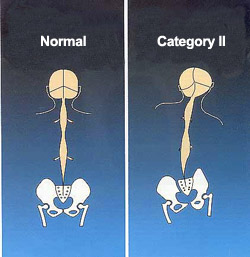
The normal weight-bearing mechanism (as depicted on the INTRODUCTION TO SACRO-OCCIPITAL TECHNIQUE brochure) distributes the weight of the body down from the top of the skull, through the spine, directly into the sacrum. At the level of the second sacral segment, the force is then distributed equilaterally out through both legs and down to the floor. When you are balanced on two feet, you should be able to stand perfectly still, with absolutely no muscular activity anywhere in your body except in your calf muscles, as they maintain your balance.
People with a Category II Complex are unable to maintain a balanced two-footed stance. They find it very uncomfortable and shift from one foot to the other repeatedly. If forced to stand for a long time, they become exhausted and/or begin to be in pain. This is due to the disarrangement of the sacroiliac weight-bearing joint.
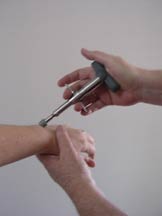 When the sacroiliac joint has been compromised, a number of consequences follow. The muscles in the body begin to spasm in an effort to hold the body upright. People with this problem experience pain and tenderness in the upper shoulder on the side of the injury and often may have upper extremity pain and dysfunction. In addition, the ankles, knees, and arches of the feet are distorted, because the body's muscles are pulling on the knees, as well as the shoulders, in an effort to keep the pelvis level. In the brochure, there are a list of symptoms associated with this dysfunction. The involved areas may include the following: a) jaw problems; b) neck pain; c) ear pain, loss of balance, and tinnitus; d) lateral headaches; e) shoulder, arm, and hand pain; f) lateral chest pain; g) groin pain; h) lateral thigh pain; i) knee, ankle, and feet problems; j) hypoglycemia; k) menstrual problems; and 1) low back pain.
When the sacroiliac joint has been compromised, a number of consequences follow. The muscles in the body begin to spasm in an effort to hold the body upright. People with this problem experience pain and tenderness in the upper shoulder on the side of the injury and often may have upper extremity pain and dysfunction. In addition, the ankles, knees, and arches of the feet are distorted, because the body's muscles are pulling on the knees, as well as the shoulders, in an effort to keep the pelvis level. In the brochure, there are a list of symptoms associated with this dysfunction. The involved areas may include the following: a) jaw problems; b) neck pain; c) ear pain, loss of balance, and tinnitus; d) lateral headaches; e) shoulder, arm, and hand pain; f) lateral chest pain; g) groin pain; h) lateral thigh pain; i) knee, ankle, and feet problems; j) hypoglycemia; k) menstrual problems; and 1) low back pain.In addition I have observed: prostate problems, hiatal hernia, digestive problems, and chronic fatigue syndrome associated with this distortion.
As the Category II Complex persists for a longer period of time, the body begins to compensate by involving other structures. There are two joints in the body which contain proprioceptive fibers (gravity relating fibers). These are the sacroiliac (S.I.) joint and the temporomandibular joint (TMJ).
[See Treatments/Chiropractic/Temporomandibular Joint]
When the S.I. joint is no longer able to maintain a level and stable relationship to gravity, the body compensates by using the TMJ to keep the inner ear and midbrain level to the horizon. If you have ever observed a person with Sprengel's deformity (a hunchback), you would notice that no matter what the position into which they have to twist their neck, they keep their eyes level to the horizon. That level position is monitored neurologically through the TMJ. Without that compensation, the vestibular mechanism in the inner ear will fail and vertigo will result.
The Category II Complex presents a similar, although less severe, problem. The tiny muscles in the jaw region rotate the temporal bones opposite to the pelvic rotation to stabilize the musculoskeletal system. Some of the symptoms of TMJ involvement are headaches, grinding your teeth at night in bed, tinnitus and/or loss of balance.
People who have TMJ involvement with the Category II Complex have progressed into a more dysfunctional state, with the most severely dysfunctional being a decompensated pattern. Once you have been stabilized, only trauma can derange the Category II mechanism.
Dr. Richards can determine where you exist on this spectrum at the time of your initial examination.
Does this seem helpful? If so, see our information on Consultations.
Chiropractic | Cranial
[See Treatments/Chiro/Cranial]Temporomandibular Joint Dysfunction (TMJ)
The temporomandibular joint (TMJ) is one of only two joints in the body that allow you to relate to gravity. Its primary function, when normal, is to maintain the relationship of the vestibular mechanism in your inner ear (your sense of balance), your midbrain and your eyes with respect to the horizon. The TMJ contains the same type of proprioceptive fibers as are found only one other place in the body - the sacroiliac joint. These fibers are gravitational fibers which allow the body to orient itself with respect to the horizontal and vertical planes.The function of the TMJ is best observed in people who have Sprengel's deformity (a hunchback). In people with that problem, the neck is very contorted. The overriding neurologic datum is the position of the horizon and all other positional considerations take second place to that first priority.
With regard to the cranial structures, the occlusal plane (where the teeth meet) functions as the "floor." The cranial vault is stabilized by the proper position of the temporal bones with regard to the mandible - hence, the temporomandibular joint. The primary weight bearing structures for the TMJ are the second and third molars on both sides of the jaw, both upper and lower. Therefore, loss of teeth or poor occlusion in the area of the second and third molars compromises the cranium's ability to relate to gravity.
Furthermore, there is an intimate neurologic connection between the mandible, the occlusal plane and the upper cervical spine. In fact, alterations in TMJ position cause alteration of the cervical spinal curvature, muscle contractions in the cervical region and can, in the long term, lead to the development of arthritis in the anterior cervical spine. (For more information, contact the RFHC for a copy of the articles "Understanding Your TMJ" and "Dental Function and the Cervical Spine,") The occlusal plane needs to be level with the floor for the cervical curve to be normal. An orthopedic splint is often utilized to normalize the biting position.
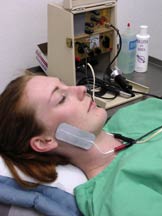 A more serious ramification of TMJ dysfunction (and one which is rarely seen) is compromise of the cerebral circulation. Due to the muscle contracture in the cervical region and the torquing of the cranium as a result of a TMJ imbalance, some people will experience ischemia (lack of blood supply) to vital brain structures. The carotid artery bifurcates at the level of C3 forming the external and the internal carotid arteries. The other major vessel to the brain is the vertebral artery which passes through the transverse processes of the cervical spine and enters the cranium through the foramen magnum. The vertebral artery then forms the basilar artery and together with the internal carotid artery forms the Circle of Willis at the base of your brain, which provides all of the blood flow to the internal structures of the brain. In certain individuals, due to a combination of factors including upper cervical subluxation, an unstable pelvis (often traumatic) and severe TMJ dysfunction, I have seen people experience bizarre neurologic patterns which are inexplicable by modern medical theory. These include heart arrhythmias which are non-cardiac in origin; vertigo; and a pattern which mimics vertebral artery insufficiency. Vertebral artery insufficiency is a congenital condition which is due to narrowing of the vertebral artery on one side, which compromises circulation to the brain. In these people, turning the head can result in total occlusion of the blood flow on one side. The symptoms include numbness and tingling around the mouth, nystagmus and rapid eye movements, vertigo and other symptoms commonly associated with cerebral ischemia.
A more serious ramification of TMJ dysfunction (and one which is rarely seen) is compromise of the cerebral circulation. Due to the muscle contracture in the cervical region and the torquing of the cranium as a result of a TMJ imbalance, some people will experience ischemia (lack of blood supply) to vital brain structures. The carotid artery bifurcates at the level of C3 forming the external and the internal carotid arteries. The other major vessel to the brain is the vertebral artery which passes through the transverse processes of the cervical spine and enters the cranium through the foramen magnum. The vertebral artery then forms the basilar artery and together with the internal carotid artery forms the Circle of Willis at the base of your brain, which provides all of the blood flow to the internal structures of the brain. In certain individuals, due to a combination of factors including upper cervical subluxation, an unstable pelvis (often traumatic) and severe TMJ dysfunction, I have seen people experience bizarre neurologic patterns which are inexplicable by modern medical theory. These include heart arrhythmias which are non-cardiac in origin; vertigo; and a pattern which mimics vertebral artery insufficiency. Vertebral artery insufficiency is a congenital condition which is due to narrowing of the vertebral artery on one side, which compromises circulation to the brain. In these people, turning the head can result in total occlusion of the blood flow on one side. The symptoms include numbness and tingling around the mouth, nystagmus and rapid eye movements, vertigo and other symptoms commonly associated with cerebral ischemia.Other parts of the body which can be affected by TMJ problems are the extremities. The posterior columns of the spinal cord pass through the foramen magnum. The posterior columns carry the sensory and motor innervation to the extremities. Therefore, you can have extremity symptoms including numbness, tingling, weakness, pain, etc.
Normal function of the temporomandibular joint and the sacroiliac joint involve a reciprocal motion when walking. In the presence of an unstable pelvis (Category II Complex) [see Treatments/Chiro/Cranial], it may not be possible to stabilize the sacroiliac joint without the use of an orthopedic splint. The splint provides a stable base, allowing the cranium and pelvis to unwind and begin to function normally together. Should you require a splint you will be referred to a specialist who will work closely with you and me.
We have technical articles available for those wishing to understand more. Included is a discussion entitled "Brain Mapping Before and After SOT Category II Blocking of the Sacroiliac Joint." This rather technical article shows that aberrations in the sacroiliac joint can interfere with brain activity. In fact, correction of the sacroiliac joint improves brain function. As noted in the report, this may be due to a variety of effects including abnormal cervical positioning, and/or the interference of the TMJ with the neurology of the brain.
Does this seem helpful? If so, see our information on Consultations.
[TOP]
TMJ Questionnaire
Note: we suggest that you select the text of this questionnaire and copy it to a word document so that you can answer the questions and determine your score.1. I experience some pain, fatigue or discomfort when talking. True__ False__.
a. If true, my pain is __mild __moderate __severe
2. I am able to take care of my teeth and gums in a normal fashion without restriction and without pain, fatigue or discomfort. True__ False__.
a. If false, I have limited opening pain discomfort ___mild ___moderate ___severe
3. I can eat and chew anything I want without pain, discomfort or jaw tiredness. True__ False__.
a. If false, my pain/fatigue/discomfort is ___mild ___moderate ___severe
4. I enjoy a normal life and/or recreational activities without restriction. (For example, I can sing, cheer, laugh, play at amateur sports and hobbies, play musical instruments, etc.)True__ False__.
a. If false, I experience
___Increased discomfort with these activities
___Increased discomfort or the fear of aggravation limit the more energetic parts of my social life.
___I engage in very little social activity due to increased discomfort or pain.
5. I can yawn or open my mouth fully in a normal fashion, painlessly. True__ False__.
a. If false, there is
___Sometimes discomfort
___Always discomfort
___I am restricted by pain
___I am severely restricted by pain.
6. I am able to engage in all customary sexual activities and expressions without limitations and/or without causing headache, face or jaw pain. True__ False__.
a. If false,
___I sometimes experience headache, face, jaw pain or jaw fatigue
___It usually causes enough pain to markedly interfere with my enjoyment, willingness and satisfaction.
___I limit my activities due to limited mouth opening.
___I abstain from sexual activity because of the head, face or jaw pain it causes.
7. I sleep well in a normal fashion without any pain, medication, relaxants or sleeping pills. True__ False__.
a. If false,
___I sleep well with the use of pain pills, anti-inflammatories or medicinal sleeping aids.
___I fail to realize 6 hours of restful sleep even with the use of pills
___I fail to realize 4 hours of restful sleep even with the use of pills
___I fail to realize 2 hours of restful sleep even with the use of pills
8. I have been treated in the past for headaches, jaw pain or face pain. True__ False__.
a. If true,
___Some form of treatment completely controls my pain
___I get partial but significant relief through treatment
___I don't get much relief from any form of treatment
___There is no treatment to date which has helped me enough to make me want to continue.
9. I do not experience ringing in my ears. True__ False__.
a. If false,
___I experience some ringing, but it doesn't interfere with my sleep or my ability to perform my daily activities.
___The ringing in my ears interferes with my sleep and daily activities, but I can accomplish my goals and get enough sleep.
___I have marked impairment in my daily activities and an unacceptable loss of sleep due to the ringing in my ears.
___The ringing in my ears is incapacitating and it forces me to use a
masking device (white noise) to get any sleep.
10. I do not experience dizziness or lightheadedness. True__ False__.
a. If false,
___The dizziness does not interfere with my daily activities.
___The dizziness somewhat interferes with my daily activities but I can accomplish my goals
___The dizziness causes a marked impairment in my daily activities.
___I experience incapacitating dizziness.
If you have more than 2 positive answers, you probably need TMJ treatment.
Do you think you have this condition? If so, see our information on Consultations.
[TOP]
Does Chiropractic Cause Stroke?
In 1994, there was a spate of negative media articles about chiropractic first on 20/20 (NBC), then on The Crusaders (NBC) and, in the June issue of Consumer Reports. I thought you might like some background information on what is going on and some data regarding the motivation for these allegations.Perhaps the most sensational allegation that has been made is that chiropractic cervical manipulation "causes" strokes. This one made the Associated Press and was on the nightly news all over the country and Europe. The Crusaders even showed an angiogram of a perfectly normal vertebral artery while the M.D. they were interviewing said it clearly showed a "ripped" artery from manipulation.
The actual incidence of vascular accident from forceful manipulation of the cervical spine is two cases per million treatments, or .0002%. By comparison the risk of death from chymopapain injections administered by orthopedic surgeons for back and leg pain is 1400 deaths per million, or .14%. The risk of paralysis from neurosurgery for neck pain is 15,000 cases per million, or 1.5%
Even though the risk of a 'ripped' artery is minute, if it were to happen to you, or some one you loved, those statistics would be meaningless - for you the incidence of risk would be 100%. Over a year and a half ago, I attended a national seminar designed to alert doctors of chiropractic so that they could identify just who was at risk for vertebral artery dissection-what to look for, what questions to ask, how to perform a pre-screening test before rotary manipulation of the cervical spine. In short, it was a risk reduction seminar designed to identify and screen out people with potential adverse reactions to rotary cervical manipulation.
What is the real issue?
However, there is more behind this media campaign than simple disinformation. In all 3 media instances cited earlier, reputable, distinguished members of the chiropractic profession were interviewed. Yet, almost no space or air time was given to their comments. Instead Dr. Murray Katz of the National Association of Chiropractic Medicine (NACM) was featured prominently in two instances. Just who is he and what group does he represent? Dr. Katz is a long time foe of the chiropractic profession. Most recently, he testified before the New Zealand Commission on Chiropractic. The Commission concluded: "Having regard to Dr. Katz's general demeanor as a witness as we observed him during the three days of his submissions and evidence, we are abundantly satisfied that it would be quite unsafe to rely on his opinions, or on any evidence on matters of fact which were not completely verified from an independent and reliable source."
An interesting feature of Dr. Katz' testimony was that he had materially influenced the views of the Executive Director of the United States Consumer Union. The June Consumer Reports certainly seems to verify his claim, particularly when you consider that NACM is a splinter group of approximately 50 to 100 doctors who are attempting to form a new profession called "Orthopractic" in conjunction with medical doctors, osteopaths and physical therapists. In their membership campaign to other members of the profession the major inducement to join is acceptance by the AMA. Yet, this group is recommended by Consumer Reports in preference to the 48,000 plus licensed chiropractors in the US and the 3,000 plus in Canada. As of December 2000, Dr Katz continues his disinformation campaign. However, his success has been limited.
In the 1980's the AMA was solidly defeated in Federal Court by the chiropractic profession. The judge found them guilty of restraint of trade and of trying to destroy the chiropractic profession. It appears that the AMA has found a new venue in its attempts to undermine the chiropractic profession.
Our chiropractic organizations are attempting to get the facts out; but, interestingly, our major national associations do not have enough money to obtain the kind of coverage these smear campaigns were given. It makes me wonder what the motives truly are and whose deep pockets they're tapping into.
For those of you interested in more of the scientific studies, I have the May 1994 issue of The Chiropractic Report, which cites 46 different peer-reviewed studies and discusses the risks and the benefits of manipulation vs. certain medical procedures. I also have two issues of Dynamic Chiropractic (6/3 and 6/17 1994) which have multiple background articles. [Contact the RFHC for copies of the articles]
Chiropractic is thriving
Chiropractic is 100 years old. In spite of all the opposition and fear campaigns brought against us, chiropractic has continued to thrive. The reason is simple - millions of people have received valuable help. These people - people like you - know how chiropractic has improved their lives, and it is because of them that we continue to survive and flourish. I hope this discussion let's you understand some of the politics behind what's going on. I hope, too, that I've allayed whatever concerns you may have had. Your job is to get well. My job is to help you. Thank you for your continuing trust.
[TOP]
Case Profiles
Case Profile (Chiropractic)
I was going to a chiropractor for vertigo and headaches. Though I did experience some relief, the results were just temporary. My mother, who is a patient at RFHC, suggested that I visit Dr. Richards.
"Since I've been treated by Dr. Richards, the vertigo is under control and my headaches are gone. And whenever I feel that I might be having some problems, I make an appointment with Dr. Richards and we usually take care of the dizziness before it gets bad.
Case Profile (Chiropractic)
"Dr. Richards is the most knowledgeable doctor in her field.
"After being in bed for two months I was all set to have back surgery in February of 1991. 1 went to two orthopedic specialists and one neurosurgeon. They had me taking Empirin with codeine. I made the decision to see Dr. Richards when I could no longer stand taking the medicine.
"I dragged myself out of bed and went to her office. In only a few treatments, I was able to walk out of her office with little pain. I was able to slowly build up my strength and now I could go golfing ... without the medicine! Thanks to Dr. Richards, I am able to lead a more normal life." --RC
Conservative care is often a realistic alternative to surgery. Happily, this was one of those cases. It was a privilege to be of service to someone I've known for so long. --Dr. Richards
Case Profile (Chiropractic)
When I first came to Dr. Richards, a little over a year ago, it was a major leap of faith, on the recommendation of a trusted friend. My previous experiences with chiropractors did not have much more than a band aid effect. I was desperate and on the verge of quitting a job I loved.
The pain and stiffness in my neck had me on dangerous painkillers. I could not turn my head far enough to safely back my car out of a parking place. My feet felt as if they had been boiled in oil. The metatarsal bars on the soles of every pair of shoes I've owned since the late 60s could no longer relieve the pressure on the tender balls of my feet. I was on the verge of "roller skating off the nearest pier" when I began the 65 mile trek to Dr. Richards. In this year I have learned more about my body and how it works than I really wanted to know (sometimes). I changed my diet, exercised more and developed an attitude of perfect health inside and out. All done with TLC and humor. The visits were actually fun (sometimes).
I have now graduated from twice a week to every two months, as needed. My neck hasn't even tweaked in months. The biggest thrill of all came at a dear friends 50th anniversary party. I WORE NEW "HIGH HEELED SHOES" WITHOUT METATARSAL BARS AND 'DANCED ALL NIGHT". NEED I SAY MORE? --EK
Case Profile (Chiropractic)
"Having been treated by her for more than seven years, I know that Dr. Richards knows my body pretty well. Originally I came to the RFHC for my scoliosis and general back pain, and since I've been treated by Dr. Richards, the scoliosis has never given me any problems.
"I kind of know when something in my back goes out so when I feel that something has been pushed out of place, I go to Doc and she fixes me up. She basically keeps me going." --CK
[TOP]
© 2013, Dr N Rowan Richards. This site or any part may not be reproduced without the written consent of Richards Family Health Center. N Rowan Richards, DC, DABCI, FIACA at 727 Lee Court, Twin Falls ID 83301. 626.303.3162. email:frontoffice@richardsfamilyhealth.com. This site is Not intended to dispense health advice or serve as a substitute for actual patient contact with a qualified healthcare provider. Our sole purpose is one of education. It is our expectation that our site can educate our visitors about the efficacy of some healthcare treatments that exist as an alternative to conventional medical wisdom.
PRIVACY POLICY: Richards Family Health Center takes your privacy very seriously. Be assured that we do not sell or rent your contact information to anyone.


